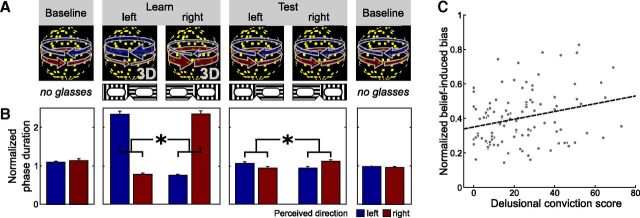Figure 2.
Delusional ideation and belief-induced bias. A, Schematic illustration of Behavioral Experiment 2 and the fMRI experiment. Higher-level cognitive beliefs were induced by a placebo-like experimental manipulation. Participants viewed continuously a DK that is perceived as a rotating sphere and indicated changes in perceived rotation direction by button presses. In the initial and final baseline phases and in the test phase, the rotation direction of the sphere was ambiguous, yielding bistable perception alternating spontaneously between leftward and rightward rotation direction. In the learning phase, stereoscopic depth cues were surreptitiously added to the stimulus, which forced the sphere to rotate in one direction 80% of the time. In the learning and test phase, participants wore transparent glasses, which they believed to contain polarizing filters and to bias their perception toward one rotation direction, depending on the orientation of the glasses. B, Effect of beliefs on reported perception (*p < 0.001, paired t test, p value based on 10,000 permutations). Bars show the mean phase duration of each percept normalized with respect to the mean phase duration in the baseline runs. Error bars denote SE. C, Correlation between tendency toward delusional convictions and belief-induced bias (r = 0.26, p = 0.004, product-moment correlation, p value based on 10,000 permutations). Tendency toward delusional convictions was measured with a validated questionnaire (Peters et al., 1999). Belief-induced bias was calculated as the ratio of belief-congruent and belief-incongruent mean phase durations normalized with respect to the learning phase. Higher values indicate a stronger belief-induced bias. Each dot represents one participant. The dashed line illustrates the fitted regression line.

